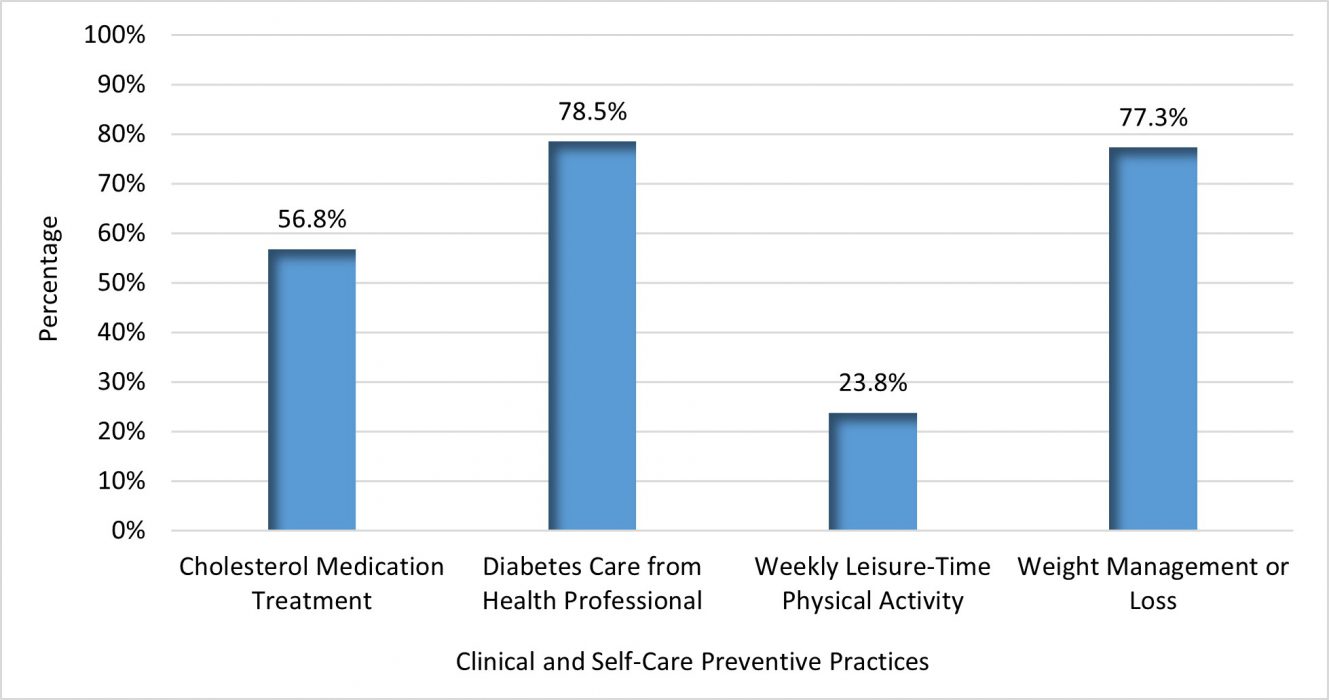Preventive Care Practices
‹View Table of Contents

Diabetes-related complications can be serious, costly, and deadly. They include heart disease, stroke, kidney disease and kidney failure, blindness, and amputations of the legs and feet. Diabetes-related complications are more likely and more severe among people whose diabetes is not well managed and those who have had diabetes longer.
People with diabetes can better manage their condition and improve their health by following evidence-based self-care and clinical preventive practices (e.g., preventive care practices) recommended by CDC and others.23 These practices include getting regular A1C tests and annual foot and eye exams, attending DSMES classes, engaging in physical activity, not smoking, and monitoring blood sugar daily.
Healthy People 2020 set national objectives for improving the health of all Americans and monitors progress toward increasing the percentage of people with diagnosed diabetes who follow preventive care practices. Table 3 shows Healthy People 2020 preventive care practice targets and the all-states median percentages for each practice during 2011–2018.
| Two or More A1C Tests in the Last Year | Foot Exam by Health Care Professional in the Last Year | Ever Attended a Diabetes Self-Management Class | Dilated Eye Exam in the Last Year | Daily Self-Monitoring of Blood Sugar | |
|---|---|---|---|---|---|
| Healthy People 2020 Target | 72.9 | 76.7 | 62.5 | 58.7 | 72.5 |
| 2011 | 68.8 | 70.8 | 56.3 | 60.1 | 64.2 |
| 2012 | 69.2 | 69.2 | 55.3 | 59.7 | 63.6 |
| 2013 | 67.3 | 69.2 | 55.8 | 59.6 | 64.1 |
| 2014 | 68.1 | 68.1 | 55.3 | 58.9 | 63.5 |
| 2015 | 71.4 | 71.6 | 54.4 | 61.6 | 63.0 |
| 2016 | * | * | * | * | * |
| 2017–2018^ | 75.2 | 75.2 | 52.0 | 69.0 | 61.5 |
Notes: Percentages are age-adjusted to the 2000 US standard population. Percentages in bold met or exceeded the Healthy People 2020 target. Healthy People 2030 targets will be reported when corresponding data are available.
* Indicates suppressed data or no data available.
^ Data adapted from Diabetes Self-Management Education and Association With Diabetes Self-Care and Clinical Preventive Care Practices. Analysis of 2017 and 2018 Behavioral Risk Factor and Surveillance System preventive care practices data among US adult population (≥18 years) in 43 states and the District of Columbia.
Data sources: United States Diabetes Surveillance System and Behavioral Risk Factor Surveillance System, Centers for Disease Control and Prevention.
Reporting a dilated eye exam in the last year was the only recommended preventive care practice that consistently met or exceeded the Healthy People 2020 target during 2011–2018. The target was also exceeded for the preventive care practice of receiving two or more A1C tests in the last year during 2017–2018. The lowest percentage was for ever attending a diabetes self-management class. Additional preventive care practices can also help people with diabetes improve their health. Figure 9 below shows the percent of adults with diabetes who engaged in additional preventive care practices.10
Figure 9. Percentage of Preventive Care Practices Associated With Diabetes-Related Complications Among Adults Aged 18 years or older with Diagnosed Diabetes, United States, 2015-2018

Notes: Percentages are age-adjusted to the 2000 US Census standard population. Figure adapted from CDC’s National Diabetes Statistics Report.
Data source: National Health and Nutrition Examination Survey, Centers for Disease Control and Prevention.
DSMES can increase the use of preventive care practices, help improve quality of life for people with diabetes, and reduce health care costs by lowering the risk of complications.24 Approximately 25% of people who received diabetes education followed nine to ten preventive care practices compared to 10% of people who never received diabetes education. However, only half of adults with diabetes reported ever receiving education on diabetes management, with the lowest rates reported among Hispanic adults, uninsured adults, and adults with less than a high school education.25
Barriers such as not having insurance coverage, having insurance with high co-payments, and living in a rural area can make it hard for some people to participate in DSMES. More research may help find new ways to overcome the challenges that prevent people from accessing DSMES services and address gaps in preventive care for people with diabetes.